The Asian Human Rights Commission (AHRC) has received photographs from Mr Javed Kapoor showing the extent of the gender-based violence in Pakistan and the concrete consequences of the misogynist mindset spreading within the Pakistani middle-class. The AHRC is working on those acid throwing cases as part of its involvement in denouncing human rights violations across Asia.
On 26 January 2010, a bill regarding acid violence—which would specifically target acid related crimes by providing graver punishments for the attackers and by regulating the sale and purchase of acid—will be submitted to the National Assembly of Pakistan. But this only marks the beginning of a long legislative process and it will require some time before the law is successfully adopted and effectively enforced. It will also require a strong political will, which until now, has proven inadequate, if not nonexistent. Indeed, in most of those cases, the judicial institutions have not taken stern sanctions against the perpetrators, which have often been able to walk away in total impunity. Nor has adequate compensation and support been granted to the victims.
|
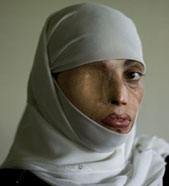 Irum Saeed, 30, poses for a photograph at her office at the Urdu University of Islamabad, Pakistan, Thursday, July 24, 2008. Irum Saeed, 30, poses for a photograph at her office at the Urdu University of Islamabad, Pakistan, Thursday, July 24, 2008.
Irum was burned on her face, back and shoulders twelve years ago when a boy whom she rejected for marriage threw acid on her in the middle of the street.
She has undergone plastic surgery 25 times to try to recover from her scars. |
|
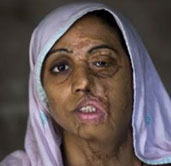 Shameem Akhter, 18, poses for a photograph at her home in Jhang, Pakistan, Wednesday, July 10, 2008. Shameem Akhter, 18, poses for a photograph at her home in Jhang, Pakistan, Wednesday, July 10, 2008.
Shameem was raped by three boys who then threw acid on her three years ago.
Shameem has undergone plastic surgery 10 times to try to recover from her scars. |
|
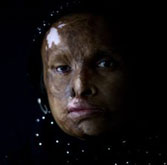 Shehnaz Usman, 36, poses for a photograph in Lahore, Pakistan, Sunday, Oct. 26, 2008. Shehnaz Usman, 36, poses for a photograph in Lahore, Pakistan, Sunday, Oct. 26, 2008.
Shehnaz was burned with acid by a relative due to a familial dispute five years ago.
Shehnaz has undergone plastic surgery 10 times to try to recover from her scars. |
|
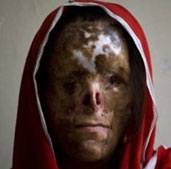 Najaf Sultana, 16, poses for a photograph at her home in Lahore, Pakistan on Wednesday, July 9, 2008. Najaf Sultana, 16, poses for a photograph at her home in Lahore, Pakistan on Wednesday, July 9, 2008.
At the age of five Najaf was burned by her father while she was sleeping, apparently because he didn’t want to have another girl in the family.
As a result of the burning Najaf became blind and after being abandoned by both her parents she now lives with relatives. She has undergone plastic surgery around 15 times to try to recover from her scars. |
|
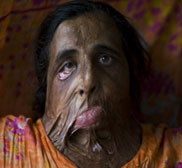 Shahnaz Bibi, 35, poses for a photograph in Lahore, Pakistan, Sunday, ct. 26, 2008. Shahnaz Bibi, 35, poses for a photograph in Lahore, Pakistan, Sunday, ct. 26, 2008.
Ten years ago Shahnaz was burned with acid by a relative due to a familial dispute.
She has never undergone plastic surgery. |
|
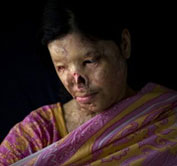 Kanwal Kayum, 26, adjusts her veil as she poses for a photograph in Lahore, Pakistan, Sunday, Oct. 26, 2008. Kanwal Kayum, 26, adjusts her veil as she poses for a photograph in Lahore, Pakistan, Sunday, Oct. 26, 2008.
Kanwal was burned with acid one year ago by a boy whom she rejected for marriage.
She has never undergone plastic surgery. |
|
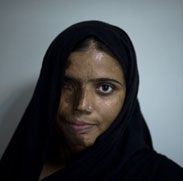 Munira Asef, 23, poses for a photograph in Lahore, Pakistan, Sunday, Oct. 26, 2008. Munira Asef, 23, poses for a photograph in Lahore, Pakistan, Sunday, Oct. 26, 2008.
Munira was burned with acid five years ago by a boy whom she rejected for marriage.
She has undergone plastic surgery 7 times to try to recover from her scars. |
|
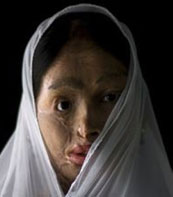 Memuna Khan, 21, poses for a photograph in Karachi, Pakistan, Friday, Dec. 19, 2008. Memuna Khan, 21, poses for a photograph in Karachi, Pakistan, Friday, Dec. 19, 2008.
Menuna was burned by a group of boys who threw acid on her to settle a dispute between their family and Menuna’s.
She has undergone plastic surgery 21 times to try to recover from her scars. |
|
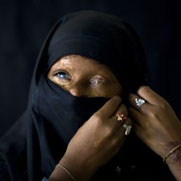 Zainab Bibi, 17, adjusts her veil as she poses for a photograph in Islamabad, Pakistan, Wednesday, Dec. 24, 2008. Zainab Bibi, 17, adjusts her veil as she poses for a photograph in Islamabad, Pakistan, Wednesday, Dec. 24, 2008.
Zainab was burned on her face with acid thrown by a boy whom she rejected for marriage five years ago.
She has undergone plastic surgery several times to try to recover from her scars. |
|
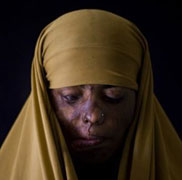 Naila Farhat, 19, poses for a photograph in Islamabad, Pakistan, Wednesday, Dec. 24, 2008. Naila Farhat, 19, poses for a photograph in Islamabad, Pakistan, Wednesday, Dec. 24, 2008.
Naila was burned on her face with acid thrown by a boy whom she rejected for marriage five years ago.
She has undergone plastic surgery several times to try to recover from her scars. |
|
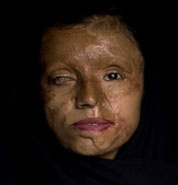 Saira Liaqat, 26, poses for the camera at her home in Lahore, Pakistan, Wednesday, July 9, 2008. Saira Liaqat, 26, poses for the camera at her home in Lahore, Pakistan, Wednesday, July 9, 2008.
When she was fifteen, Saira was married to a relative who would later attack her with acid after insistently demanding her to live with him, although the families had agreed she wouldn’t join him until she finished school.
Saira has undergone plastic surgery 9 times to try to recover from her scars. |
The case of Naila Farhat (see picture above) was brought to the Supreme Court of Pakistan in November 2008 and received enormous publicity. In this specific case, the perpetrator was sentenced to 12 years imprisonment and ordered to pay 1.2 million rupees in damages. This represents a landmark decision in dealing with gender-related violence, but the judgment could not stop the menace of acid-throwing. It is important to recognize that this decision was an exception in the landscape of acid attacks in Pakistan; in most cases the measures taken—if any—are not proportionate to the sufferings inflicted by the attacks.
Most acid-attacks are punishing measures towards women who have refused to accede to commands from men or have stood against abuses from them. The effects of these acid attacks upon their lives have been destructive: apart from the physical trauma undergone (some are scarred and maimed for life, despite numerous surgical interventions), they also have to face psychological trauma as well as social isolation and ostracism from their community. A law against acid crimes will hardly act as a deterrent when perpetrators know that if they have enough resources and leverage they can shrug off any charge held against them, no matter the atrocity.
From the victims’ point of view, there is a high risk of denial of justice, and the numerous obstacles they can face in their pursuit of justice may act as a strong disincentive preventing them from reporting the attacks. Indeed, the status of women in Pakistan, subject on the one hand to pressures not to disgrace their families by filing a case, and on the other hand, to disdain from the police officers themselves, will add to the obstacles faced by any average Pakistani seeking justice within a corrupted policing system and administration.